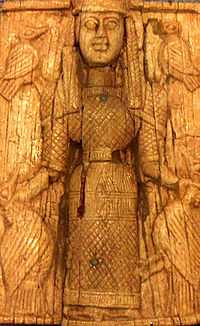Potnia Theron

Potnia Theron (Ἡ Πότνια Θηρῶν, "The Mistress of the Animals") is a term first used (once) by Homer (Iliad 21. 470) and often used to describe female divinities associated with animals.[1] The word Potnia, meaning mistress or lady, was a Mycenaean word inherited by Classical Greek, with the same meaning, cognate to Sanskrit patnī.[2]
Homer's mention of potnia theron is thought to refer to Artemis and Walter Burkert describes this mention as "a well established formula".[3] An Artemis type deity, a 'Mistress of the Animals', is often assumed to have existed in prehistorical religion and often referred to as Potnia Theron, with some scholars positing a relationship between Artemis and goddesses depicted in Minoan art and "Potnia Theron has become a generic term for any female associated with animals."[1][4]
See also
| Wikimedia Commons has media related to Potniai theron. |
- Lord of the animals
- Inara (goddess)
- Mother Goddess
- Feronia (mythology)
References
- ↑ 1.0 1.1 Fischer-Hansen, Tobias; Birte Poulsen (2009). From Artemis to Diana: the goddess of man and beast. Museum Tusculanum Press. p. 23. ISBN 978-8763507882.
- ↑ Chadwick, John (1976). The Mycenaean world. Cambridge University Press. p. 92. ISBN 978-0-521-29037-1.
- ↑ Burkert, Walter (1987). Greek Religion. Harvard University Press. p. 149. ISBN 978-0-674-36281-9.
- ↑ Roller, Lynn E. (1999). In search of god the mother: the cult of Anatolian Cybele. University of California Press. p. 139. ISBN 978-0-520-21024-0.
indefinite figures such as the Potnia Theron